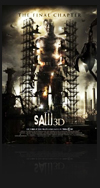Special Note: "Saw VII" is being released theatrically with the on-screen title "Saw 3D," a moronic moniker that won't make a lick of sense once it comes to DVD and Blu-ray in good, old-fashioned two dimensions. Clearly the makers weren't thinking when they opted for this flash-in-the-pan title. Then again, there's plenty of proof in the movie itself that no one was thinking much about anything but the bottom line. In lieu of being outdated in three months, the following review will refer to the film by the name it ought to have been all along, "Saw VII."
Seven years, seven movies. If Lionsgate's marketing campaign is to be trusted, "Saw VII" has been set up as the final chapter in the blood-drenched-but-worn-dry horror series (if the empty multiplex auditorium I saw the film in the Thursday night before its official Friday release is any indication, it just might be). As such, it makes the ultimate case for why the franchise should have ended after 2006's "
Saw III," easily the tightest and craftiest of all the entries as it satisfyingly tied up the various plot threads and killed resident villain John Kramer/Jigsaw Killer. Where there was money to still be made, there were further sequels to be thrown together, with 2007's "
Saw IV" and 2008's "
Saw V" especially lame, convoluted and amateurish. In death, John Kramer returned time and time again in flashback sequences as the tacked-on continuation of the story seemingly was pulled from the asses of screenwriters Patrick Melton and Marcus Dunstan.
Following the brief uptick in quality with the stylish, thematically
richer—but still, by this point, tedious—"
Saw VI," "Saw VII" opts for
something altogether different, but not necessarily better. In lieu of
treating the purportedly last installment with any sort of seriousness or
reverence, director Kevin Greutert has thrown all logic to the wind. From
an aesthetic standpoint, "Saw VII" outclasses its predecessors with a
fuller, brighter tone, scope and color scheme. For once, scenes actually
take place in exterior locations during the daytime as opposed to being
solely set in cold, dank, dilapidated warehouses. Otherwise, this grisly
anticlimactic offering is bound to piss fans off, becoming so brazenly
far-fetched that it actually poses a slew of new questions while answering
almost none of the old ones. If this really is the final film in the
series, it comes off as a rotten joke that laughs in the face of anyone who
has followed the ongoing corkscrew narrative and expected it to properly
wrap things up. Instead, the picture's conclusion is just as open-ended as
any of the past ones.
 |
Narrowly escaping a trap set for him by Jill (Betsy Russell) at the behest
of her late, cancer-stricken husband John (Tobin Bell), homicidal protege
Detective Hoffman (Costas Mandylor) loses what was left of his mind and
sets about on a rampage that he hopes to culminate with revenge against
Jill. Meanwhile, author Bobby Dagen (Sean Patrick Flanery) has just
released a book detailing his survival of the Jigsaw Killer's wrath. The
only problem: not a word of it is true. Now, with wife Joyce (Gina Holden)
held hostage, Bobby has one hour to make his way through a maze of
nightmarish tests or risk losing the person he loves most.
 |
"Saw VII" is beyond stupid, not the least bit interested in even bare
coherence. Ridiculous from the start in a very giddy, unapologetic sort of
way, the film opens with a complex trap taking place in a glass enclosure
beside a busy city street, onlookers terrified and helpless as they watch
two friends (Sebastian Pigott and Jon Cor) decide if they are going to kill
each other with an electrical buzz saw or sacrifice the life of an
unfaithful mutual girlfriend (Anne Greene). From there, one's suspension of
disbelief is required as the movie gets all the more goofy. Are we really
to believe Bobby Dagen has published a book about his survival against
Jigsaw without a single person calling him out on his blatant mistruth? How
are there gobs of new survivors the series had previously not mentioned all
of a sudden coming out of the woodwork? How are the overly elaborate Rube
Goldberg traps Hoffman is responsible for even halfway feasible? A magician
couldn't even pull together what Hoffman has managed by himself. Meanwhile,
the use of the tricycle-riding clown doll shoots right into laughable
territory this time as it continually shows up and mouths out Hoffman's
pre-recorded messages on cue.
 |
If all the viewer cares about are the torture sequences, they will be
happy to know that "Saw VII" has notably more than any in the past. In
fact, in between the fleeting exposition scenes full of bad writing and
embarrassing performances, the movie is nothing but violent, gory
set-pieces. Without anyone likable to care about, it all comes off as even
more exploitative than the norm. Taken at face value, however, they up the
ante an extra notch in their ghoulish imagination and certainly keep the
unsettling energy levels high. Especially effective is one scene where a
racist man's bare back is glued to a car seat, his inability to be set free
causing a horrific chain reaction of death, and another where Bobby must
get ahold of a key from publicist Nina (Naomi Snieckus) that has been
hooked on a string and buried deep in her intestines.
Without giving away the details, Dr. Gordon (Cary Elwes) from 2004's original "
Saw" does, indeed, make a prominent return appearance. How he is used will both surprise and bewilder, though, especially during a final act that creates countless plot holes and fails to conclude in a way that does the series justice. Bigger and bolder in its body count but not even half as smart as the other "Saw" films, "Saw VII" replaces its signature morose atmosphere with sheer brain-numbing goofiness and a lack of respect for faithful audiences. Go in expecting any sort of closure, and you'll be in for a rude awakening.



















 (for grisly bloody violence and language).
(for grisly bloody violence and language).